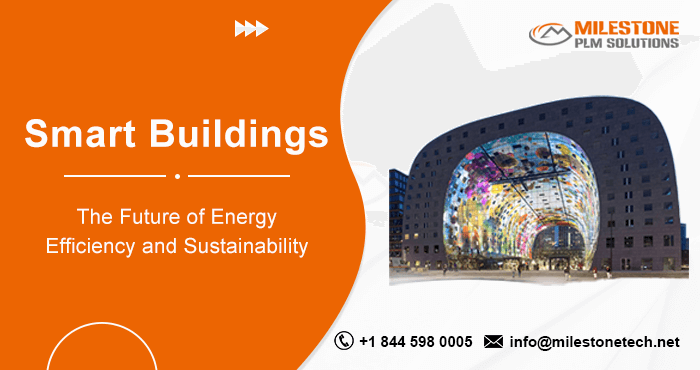Smart Buildings- The Future of Energy Efficiency and Sustainability

Smart Buildings: In an era where energy efficiency and sustainability are paramount, smart building are emerging as the linchpin of modern architecture and urban planning. These innovative structures are revolutionizing how we think about energy consumption, environmental impact, and living conditions. By integrating advanced technologies, smart building are not only enhancing energy efficiency but also contributing significantly to global sustainability goals.
Understanding Smart Buildings
A smart building is an advanced structure equipped with integrated technologies to optimize performance, energy efficiency, and occupant comfort. These buildings utilize Internet of Things (IoT) devices, sensors, and artificial intelligence (AI) to monitor and control various systems such as heating, ventilation, air conditioning (HVAC), lighting, security, and more. The core idea is to create an intelligent environment that adapts to the needs of its occupants while minimizing energy usage and environmental impact.
Energy Efficiency in Smart Buildings
Energy efficiency is a cornerstone of smart building technology. Traditional buildings often operate inefficiently, leading to excessive energy consumption and higher operational costs. In contrast, smart buildings are designed to optimize energy use through several innovative methods:
- Automated HVAC Systems: Smart HVAC systems use sensors and AI to adjust heating and cooling based on real-time occupancy and weather conditions. This ensures optimal temperature control while reducing unnecessary energy consumption.
- Advanced Lighting Controls: Smart lighting systems can adjust the intensity and color of lights based on natural light availability and occupancy. Automated dimming and switching off lights in unoccupied areas significantly cut down energy waste.
- Energy Monitoring and Management: Smart building are equipped with advanced energy monitoring systems that track usage patterns and identify inefficiencies. Building managers can use this data to implement energy-saving measures and improve overall efficiency.
- Renewable Energy Integration: Smart buildings often incorporate renewable energy sources such as solar panels and wind turbines. Advanced energy management systems ensure the efficient use of these resources, storing excess energy in batteries for later use.
Sustainability Benefits of Smart Buildings
Beyond energy efficiency, smart buildings play a crucial role in promoting sustainability. They contribute to reducing the carbon footprint and conserving natural resources in several ways:
- Reduced Carbon Emissions: By optimizing energy use and integrating renewable energy sources, smart buildings significantly cut down on greenhouse gas emissions. This aligns with global efforts to combat climate change and achieve carbon neutrality.
- Water Conservation: Smart buildings use advanced plumbing systems that reduce water waste. Sensors and automated controls ensure efficient water usage, detect leaks, and provide timely maintenance alerts.
- Waste Management: Intelligent waste management systems in smart buildings help in sorting and recycling waste efficiently. Smart bins equipped with sensors can monitor waste levels and optimize collection schedules, reducing the environmental impact of waste disposal.
- Sustainable Materials: The construction of smart buildings often involves the use of sustainable and eco-friendly materials. These materials reduce the environmental impact during construction and enhance the building’s overall sustainability profile.
Enhancing Occupant Comfort and Productivity
Smart buildings are designed with the occupants in mind, providing a comfortable and healthy environment that boosts productivity and well-being:
- Air Quality Monitoring: Smart buildings are equipped with air quality sensors that monitor and maintain optimal indoor air quality. This reduces the risk of respiratory issues and enhances occupant health.
- Adaptive Environments: Through the use of IoT and AI, smart buildings create adaptive environments that respond to the preferences and habits of occupants. Personalized lighting, temperature settings, and automated adjustments contribute to a more comfortable living and working space.
- Enhanced Security: Advanced security systems in smart buildings use biometric access controls, surveillance cameras, and AI-driven threat detection to ensure the safety and security of occupants.
Challenges and Future Prospects
Despite the numerous advantages, the adoption of smart buildings faces challenges. High initial costs, data privacy concerns, and the need for skilled professionals to manage these advanced systems are significant hurdles. However, as technology advances and becomes more affordable, the adoption of smart buildings is expected to increase.
Looking ahead, the future of smart buildings is promising. Continued advancements in AI, IoT, and renewable energy technologies will further enhance the efficiency and sustainability of these buildings. Governments and organizations worldwide are recognizing the importance of smart buildings in achieving energy efficiency and sustainability goals, leading to increased investments and supportive policies.
Conclusion
Smart buildings represent the future of energy efficiency and sustainability in architecture and urban planning. By integrating advanced technologies, these buildings optimize energy use, reduce environmental impact, and enhance occupant comfort and productivity. While challenges remain, the ongoing advancements and growing recognition of the benefits of smart buildings promise a sustainable and energy-efficient future. As we move forward, the widespread adoption of smart buildings will be crucial in our global efforts to create a greener, more sustainable world.
Follow Milestone PLM Solutions for AEC Industry Updates, CAD Tips and Global Construction News.
Milestone PLM Solutions with its exclusive delivery center in India is a global CAD, BIM outsourcing partner serving the needs of the AEC industry since 2004. MILESTONE focuses on the unique needs of clients and believe in tackling real-life problems with efficiency, smooth and ease.
The MILESTONE team can assist you with DD Set, CD Set, BIM Modeling, Rendering, walk through and more. We support multiple BIM software including AUTOCAD REVIT, Architecture cad, Cabinet Vison, Vector works etc. Our approach is to provide a dedicated team for each customer over ongoing project and deliver the quality output consistently.
With our state of art technology and large talent pool of Engineers & Architects, we are developing best in class solutions for our customers across the globe. We align with your culture and values to form unbreakable partnerships and are primed for success with over 100 employees and 150 customers in the US, Europe, India, and Asia.
You can email us at info@milestonetech.net and can log in to our website www. milestonetech.net to know more about our services and our work portfolio or contact us on +1-844-598-0005
